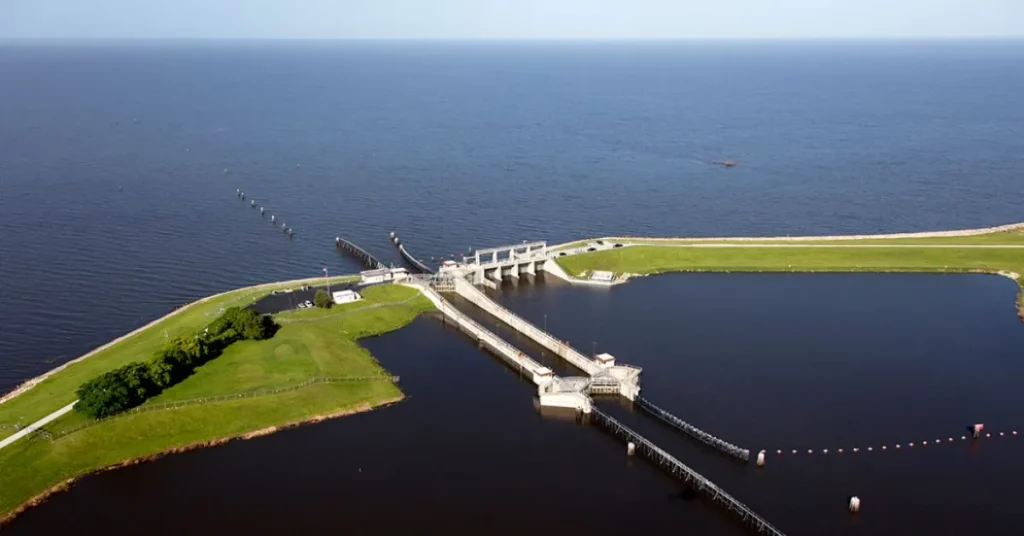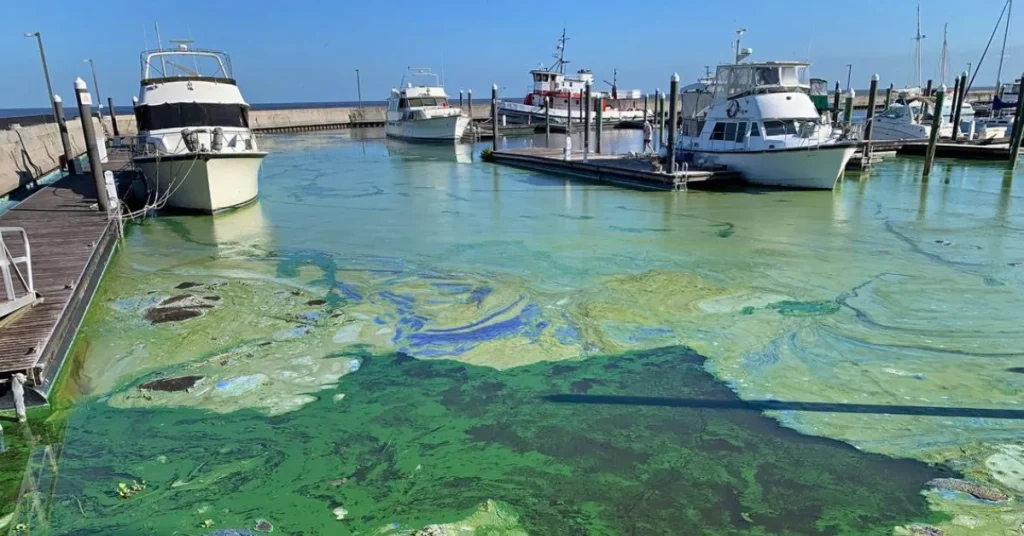Lake Okeechobee in Florida has an average depth of 9 feet. Its maximum depth is about 12 feet.
Lake Okeechobee, often referred to as Florida’s inland sea, is the largest freshwater lake in the state of Florida and the second-largest natural freshwater lake contained wholly within the United States.
Spanning over 730 square miles, this vast water body plays a critical role in Florida’s ecosystem and water management systems.
Outdoor enthusiasts and anglers are drawn to its wide expanse and its reputation for high-quality bass fishing. The lake also serves as a natural habitat for numerous species of fish and wildlife, making it an important environmental resource.
Lake Okeechobee’s shallow depth affects its water temperature and dynamics, which in turn influence the surrounding wetlands and wildlife habitats.

Lake Okeechobee’s Place In Florida’s Geography
Nestled at the heart of Florida, Lake Okeechobee boasts the title of the state’s largest freshwater lake.
Often referred to as Florida’s inland sea, its expanse plays a pivotal role in both geographic and environmental landscapes. This vast body of water is a cornerstone of the region, shaping life around it.
Location And Significance
Lake Okeechobee stands as a geographical giant in the Sunshine State. Occupying a central position, it is pivotal for water management, irrigation, and as a crossroad for unique ecosystems.
Its proximity influences weather patterns and acts as a life source for surrounding habitats.
- Central Florida: Anchor of the region.
- Hydrology: Key in the state’s water system.
- Economy: Vital for agriculture and fisheries.
Cultural And Environmental Impact
The lake’s presence is deeply interwoven with the area’s culture. It supports a rich tapestry of wildlife and plant species unique to Florida.
| Aspect | Impact |
| Biodiversity | Nurtures endemic species. |
| Recreation | Draws outdoor enthusiasts. |
| Conservation | Focus of restoration efforts. |
Environmental health is a top priority, with various initiatives aimed at maintaining and improving the lake’s condition. These efforts ensure that Lake Okeechobee remains a jewel in Florida’s ecological crown.
Peering Beneath The Surface
Lake Okeechobee, affectionately referred to as Florida’s ‘Liquid Heart,’ is not only vast in its expanse but also invites curiosity about what lies beneath its surface.
Peering into its depths reveals an ecosystem teeming with life and a lakebed filled with fascinating features. This segment of our post dives into the intriguing details of Lake Okeechobee’s depth.
Estimating The Depths
The depth of Lake Okeechobee is not uniform, variations abound throughout its area. On average, its depths achieve a modest 9 feet, with certain areas running shallower and others slightly deeper.
To comprehend the full scope of the lake’s bottom, a closer inspection through various measurement techniques is required.
Measurement Techniques
- Depth Finders: Boaters often employ sonar devices, sending sound waves to bounce off the lakebed and back to the surface.
- GPS Mapping: Advanced technology combines satellite data with sonar readings to chart the lake’s depths.
- Manual Gauging: In some cases, simple tools like weighted lines measure depth at specific points.
Each method contributes valuable data, painting a clearer picture of the lake’s underwater topography.
The resulting depth charts guide fishing excursions, navigation, and scientific research. While the average depth provides a quick snapshot, in-depth measurements reflect a dynamic underwater landscape.
Historical Water Levels And Variations
Lake Okeechobee, known as Florida’s liquid heart, has a story told through its changing depths.
These variations in water levels play a critical role in maintaining regional ecosystems and managing water resources. Understanding the lake’s historical water levels reveals insights into its health and sustainability.
Records Of Depth Changes
Through the years, Lake Okeechobee’s depth has seen significant changes. Data collection allows tracking of these fluctuations:
- Highest recorded level: Reached nearly 20 feet in 1947.
- Lowest recorded level: Dropped to about 9 feet in 2007.
Climate And Seasonal Influences
The lake’s depth is tightly linked to Florida’s climate. Seasonal patterns are key:
- Wet Season: May to November, higher lake levels due to rain.
- Dry Season: November to April, water levels dip with less rain.
Climate events like El Niño also impact the lake’s depth.
Exploring The Depths Of Lake Okeechobee

Lake Okeechobee, Florida’s liquid heart, is not just vast, but intriguingly mysterious in its depths. Known as Florida’s ‘Inland Sea’, it spans an impressive surface area, making it the second-largest freshwater lake entirely within the United States.
Yet, many are curious: how deep is Lake Okeechobee? Let’s dive into the depths of this aquatic marvel and explore what lies beneath its rippling surface.
A Look At Aquatic Life
The waters of Lake Okeechobee teem with life, providing a habitat for a wide array of fish and birds. Here are some key highlights:
- Largemouth Bass: A favorite among anglers, flourishing in the lake’s environment.
- Bluegill and Crappie: Found throughout the lake, these species thrive in its unique ecosystem.
- Wading Birds: Species like the Great Egret and Heron frequent the lake’s shallow areas.
This diverse habitat is due to the average depth of just 12 feet, allowing sunlight to penetrate and nourish underwater communities.
Geological Features Beneath
Below the surface, Lake Okeechobee’s geological features are as compelling as its aquatic life. Key features include:
| Feature | Description |
| Mud Bottom | A thick layer of mud accumulated over centuries from decaying plant matter. |
| Limestone Shelf | Forms the foundation for the lake, underpinning the aquatic ecosystem. |
These features contribute to the lake’s shallow depth, creating a unique underwater landscape that is both simple and complex.
Human Interactions And Lake Depth
Florida’s jewel, Lake Okeechobee, has depths that surprise many. People living near the lake shape its size and depth. We must understand how our actions affect this natural wonder. This piece dives into those human interactions.
Impact Of Agriculture And Urbanization
Lake Okeechobee faces pressure from both farming and growing cities. As people settle and farm, they alter the land. This affects the water levels in our lake.
- Drainage systems pull water from the lake for crops.
- These systems can lower the lake’s water levels.
- Urban growth also demands more water.
- Building near the lake reduces its size, affecting the depth.
Let’s look at some numbers:
| Year | Urban Area Growth | Agricultural Water Usage | Lake Depth Change (approx.) |
| 1980 | 10% | 5 billion gallons/day | -2 feet |
| 2000 | 22% | 6 billion gallons/day | -4 feet |
| 2020 | 35% | 7 billion gallons/day | -5 feet |
These changes remind us of our impact on Lake Okeechobee’s depth.
Conservation Efforts
Good news is, efforts to save the lake are underway. Teams work hard to protect the lake’s health. Here’s what they do:
- Cleanup projects improve water quality.
- New policies limit water use from the lake.
- Education teaches people to care for our lake.
Conservation brings hope. It promises a brighter future for Lake Okeechobee. Our lake can stay deep and healthy if we all help.
Lake Okeechobee’s Depths Compared

Lake Okeechobee, affectionately known as Florida’s “Liquid Heart”, may not be the deepest lake but it’s rich in history and ecological importance. Let’s dive into how its depths stand against other water bodies.
Contrasting Other Florida Lakes
Lake Okeechobee holds its own amongst Florida’s numerous lakes. It has a unique depth profile that differs quite significantly from others.
It’s a shallow giant, stretching over 700 square miles with an average depth of just 9 feet.
- Lake George: Second largest in FL; deeper than Lake Okeechobee
- Lake Apopka: Fourth largest; similar shallow depths
- Lake Seminole: Much smaller; slightly deeper
Compare these Floridian waters, and one finds the “Big O” standing out with its shallow basin.
Similar Lakes Nationwide
Lakes across America present a rich tapestry of depths and sizes.
| Lake Name | Location | Average Depth (feet) |
| Lake Okeechobee | Florida | 9 |
| Lake Winnebago | Wisconsin | 15 |
| Lake Pontchartrain | Louisiana | 12 – 14 |
| Great Salt Lake | Utah | 33 (variable) |
These comparisons reveal that Lake Okeechobee’s average depth is quite modest on the national scale, providing a habitat quite different from deeper lakes elsewhere.
FAQs About How Deep Is Lake Okeechobee Fl
How Deep Is Lake Okeechobee?
Lake Okeechobee, Florida’s largest freshwater lake, has an average depth of about 9 feet, with certain areas reaching depths of up to 12 feet. Despite its size, the lake is relatively shallow compared to other large lakes.
Why Is Lake Okeechobee So Shallow?
Lake Okeechobee is shallow due to its large surface area and flat basin. Originally a shallow depression on the land, the lake was shaped by water-flow patterns and sediment deposits, not by glacial activity which creates deeper lakes.
Can You Swim In Lake Okeechobee?
Swimming in Lake Okeechobee is not advised due to factors such as fluctuating water levels, the presence of alligators, and occasional pollution concerns. Boating and fishing are more common recreational activities on the lake.
What Fish Are In Lake Okeechobee?
Lake Okeechobee is a popular fishing destination, home to species like largemouth bass, crappie, bluegill, and catfish. Its shallow waters and abundant vegetation provide excellent habitats for a variety of fish.
Conclusion
Exploring the depths of Lake Okeechobee in Florida reveals a surprising shallowness, averaging only about 9 feet. Its vast expanse, stretching over 730 square miles, belies its depth, offering a unique habitat for wildlife and a diverse set of recreational activities.
As the second-largest freshwater lake in the contiguous United States, Lake Okeechobee’s shallow waters play a crucial role in Florida’s ecosystem and water management.
Resources:
1. https://www.sfwmd.gov/our-work/lake-okeechobee
